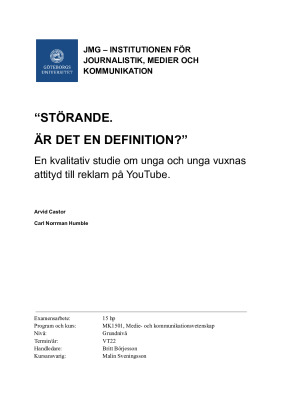STÖRANDE. ÄR DET EN DEFINITION?
En kvalitativ studie om unga och unga vuxnas
attityd till reklam på YouTube
Executive summary
The purpose of this thesis is to study and analyze how adolescents and young adults experience advertising on YouTube. We have through qualitative interviews studied our respondents’ self-experienced attitudes towards video-ads and influencer marketing, and how this may affect their YouTube consumption and/or their propensity to buy the advertised
products or services.
YouTube was founded in 2005 and started as a relatively small media platform for consumers to share videos on their own channels for others to view, but rapidly grew to the Google owned YouTube we know today. Today it is one of the biggest social media platforms with around 2.2 billion users as of the year 2021 (Statista, 2021). Nowadays social media celebrities and opinion leaders known as “influencers”, also known as “YouTubers”, rule the
platform with millions of people consuming their content. The Swedish YouTuber Pewdiepie has as of now (May 2022) over 111 million followers. Huge amounts of followers often equals huge amounts of views on their content, which attracts companies for them to advertise their products and services on. This results in a large amount of advertisements for
the consumer. The consumer therefore has to pay with their time on watching advertisements to be able to consume the actual video they want to see.
We focused our study on the group, seen in past research, that consumes YouTube the most. People ranging from 15 to 27 years old; adolescents and young adults. We wanted to study our respondents’ attitudes and reflections about advertisements on YouTube. This led us to choosing a qualitative interview-method for this study. The results, with a broader discussion
in the thesis, showed how all of our seven respondents reflected negatively on YouTube advertising, but they appreciated influencer marketing more than the traditional video-ads.
We bounced the results of theories and previous studies to help us analyze our results. The theories varied from common communication-studies theories, for instance: encoding and decoding, the two-step hypothesis and the third person effect, but also less common like Rappaport’s theory about the ways companies advertise to create a relationship between brand and consumer. Previous studies used in this thesis have examined advertising, the internet, and the effect on children, adolescents and young adults. The theories and past studies match partially or entirely with our results.
Further, we discussed the possible flaws and imperfections with what we could have done
differently, and what result we would get from another method. We also discuss what parts of
the results that surprised us, and what did not. To exemplify:
● an occuring advertising fatigue
● the respondents did not identify influencer marketing as a form of marketing at first
thought
● an existing feeling of relationship between some respondents and the influencer.

